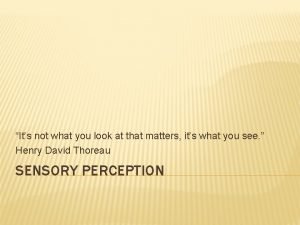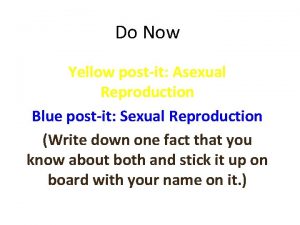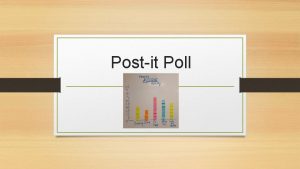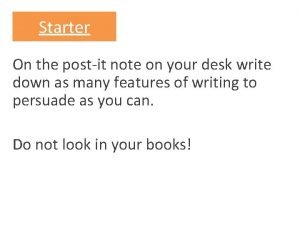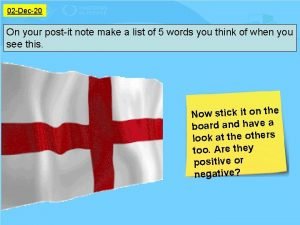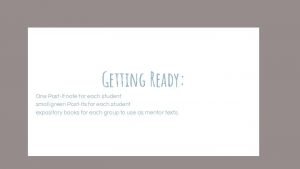When you see this postit note it means










- Slides: 10

When you see this post-it note, it means you will need to do something! Perhaps make a note, or mind-map, or annotate…or even just to think. o the t n o i duct Healy. o r t s n An i , by Mis : poem ill need y w g You antholo d n Your , pens a r Pape ghters nternet. i li high s to the s Acce A Mother in a Refugee Cam p Chinua Ach ebe Edexcel Cer tificate Anthology S ection C

Useful vocabulary Annotate your poem with your new vocabulary. (Notice that Achebe uses American spellings – be careful to remember this when quoting!) 0 Refugee (title): someone forced to leave their country 0 Madonna (line 1): a name for the Virgin Mary, Mother of Jesus, often depicted in paintings and sculpture holding the baby Jesus (the Child) 0 Odors (line 4) (American spelling): smells 0 Diarrhea (line 4) (American spelling): condition of excessive frequent and loose bowel movements, often associated with illness and disease 0 Labored (line 6) (American spelling): moving with difficulty; requiring hard work 0 Ceased (line 8): stopped 0 Consequence (line 18): importance, significance

A mother and child Make a list or mindmap – you decide what learning style works best for you. 0 What images come to mind when you think of these words: mother and child

A mother in a refugee camp Make a list or mindmap – you decide what learning style works best for you. 0 Now think about what images comes to your mind when you place the mother and child in a refugee camp

Just think about the images. Later, when looking at the poem, consider how the poet uses imagery. A mother and child – imagery and symbolism “No Madonna and Child could touch Her tenderness for a son She soon would have to forget…. ” Madonna and Child: iconic image, the ultimate symbol of motherly love, tenderness, care, affection…and death and sacrifice The powerful opening lines establish theme of the poem: the power of a mother’s love (almost Saintly? ), even in the face of death (the setting of the title = refugee camp)

A Mother In A Refugee Camp The poem Read the poem, out loud, two or three times. Think about ideas we have already covered. No Madonna and Child could touch Her tenderness for a son She soon would have to forget. . The air was heavy with odors of diarrhea, Of unwashed children with washed-out ribs And dried-up bottoms waddling in labored steps Behind blown-empty bellies. Other mothers there Had long ceased to care, but not this one: She held a ghost-smile between her teeth, And in her eyes the memory Of a mother’s pride. . She had bathed him And rubbed him down with bare palms. She took from their bundle of possessions A broken comb and combed The rust-colored hair left on his skull And then—humming in her eyes—began carefully to part it. In their former life this was perhaps A little daily act of no consequence Before his breakfast and school; now she did it Like putting flowers on a tiny grave.

Close analysis, poetic devices Sensory imagery with the smells of the camp depicted. The air is described as being ‘heavy’ with the smells – the metaphor creates an atmosphere of being claustrophobic and overwhelming. Metaphor of a ghost signals death, not just for the child but also for the mother. Is her smile now a ‘ghostsmile’ because she is now a ghost of her former self, before her life in a refugee camp? Metaphor of ‘rust’ connotes decay – the child’s life is ebbing away. Rust also suggests dirty and an almost painful process. Simile: equates what is usually a daily routine for a mother into now being an act of grief and love for a child’s death; the image is filled with pathos. A Mother In A Refugee Camp Religious imagery: iconic image of the Virgin Mary and Jesus. Have your poem Religious connotations, likening the mother to anext saint. to. Consider you and that Jesus died annotate. a tragic and brutal death, witnessed by his mother. Look also at the images of washing (away our sins? ) and the words ‘daily act’ – remind you of a Christian prayer? 1 No Madonna and Child could touch 2 Her tenderness for a son 3 She soon would have to forget. . 4 The air was heavy with odors of diarrhea, 5 Of unwashed children with washed-out ribs 6 And dried-up bottoms waddling in labored steps 7 Behind blown-empty bellies. Other mothers there 8 Had long ceased to care, but not this one: Words connected to 9 She held a ghost-smile between her teeth, time show different life once was 10 And in her eyes the memory for this woman and her 11 Of a mother’s pride. . She had bathed him child. 12 And rubbed him down with bare palms. 13 She took from their bundle of possessions 14 A broken comb and combed 15 The rust-colored hair left on his skull 16 And then—humming in her eyes—began carefully to part it. 17 In their former life this was perhaps Words of ‘broken’ 18 A little daily act of no consequence such as the comb, the 19 Before his breakfast and school; now she did it hair that is ‘left’, the 20 Like putting flowers on a tiny grave. half smile, the bodies. This is a world that is broken.

SCASI Setting Make a SCASI table. Ask questions for each section, rather than simply copying down what I have said. Asking questions will require you to ACTIVELY engage with the poem and come up with your own, and personal interpretations Make notes camp. on the setting in the poem. Where, Why, What, individual etc. • A refugee – this is where the A*s come from! NOW Remember to always WHAT choices the poet made, WHY this – WHAT effects was • Does our setting affectconsider our personalities? clickand to remove note and reveal the fullthe poet hoping to achieve with his choices. • Does this setting change thesetting mothers? Does it change this particular screen. mother? Make notes on the characters portrayed in the poem. Who, What, Where, Why. . . • A mother and her son. Remember to always consider WHAT choices the poet made, and WHY – WHAT effects was the poet • How is this mother different to the other mothers? Character hoping to achieve with his character choices. Action Style Ideas Make notes combing on the actions that‘rust-colored occur in the poem. Look for verbs. • A mother son’s hair’. The narrator remembers how she used to bathe him. Remember consider the poet and WHY – WHAT effects Achebe • Look at all to thealways mother’s actions; WHAT look atchoices the verbs used bymade, Achebe to describe what she does was for her child. What do they reveal about her as a mother? This ‘little act’ is noticeable as an act of love in the face of death. hoping to achieve with the movement / action in the poem. Make on how the poem has been written. • One notes continuous stanza, a never-ending painful Think story? about structure, rhythm, specific word choices. Does seemlines formal or informal, suggest chatty, time sombre, melancholy, sad? Remember to always consider • The itrun-on (enjambment) is running out, speeding by… WHAT poet made, andmoments WHY – WHAT • Ellipischoices are usedthe to signal different in time. effects was Achebe hoping to achieve with the structure, punctuation and devices choices in the poem. in do SCASI a reason oncehoping you have considered Setting, Character, andthe Style, • Ideas Overcomes to you. last What you for think the poet– was to make the reader think or feel when. Action they read poem? Why do you thinkto. Achebe particular poem? – this Think aboutthemes. words such as innocence, loss, you should then be able think, wrote quite this easily, about Ideas means Make notes on WHY death, suffering, love, pride, social justice and injustice. the poem has been written. What are the big issues, ideas, messages, concerns you think the poet wants the reader to be left thinking about after reading the poem? Remember to always consider WHAT choices the poet made, and WHY.

Chinua Achebe – biography 0 Nigerian poet and novelist. 0 Born 1930. 0 One of the most important living African writers. 0 Interested in politics; much of his writing considers social and political problems facing his country. 0 His first novel Things Fall Apart (1958) (you MUST read!), was hugely successful, selling between 8 -12 million copies, and translated into 45 languages. 0 Although he writes in English, he incorporates African narratives into his work. 0 Has been criticised for writing in English – using the language of colonisers. Do you agree? Make some notes. I’d also recommend your own research on Achebe.

Extension? Do you want to know more? If yes, then try some of the following: 0 Read Things Fall Apart. It’s a very short novel, and is a fantastic, and easy, read. Millions of readers around the world can’t be wrong! 0 Conduct your own research on Achebe. 0 Try a Thinking Hats approach to the poem, or other poems in the anthology. 0 Create an imagery mind-map or story board, recreating the images presented in the poem. 0 Visit the following website where a teacher has annotated the poem, line by line: 0 http: //mrhoyesgcsewebsite. com/Coursework/Section%20 C/ Refugee/Tracked%20 Poems/Refugee%20 Mother%20 and%2 0 Child%20 -%20 Christine. pdf
 Difference between note making and note taking
Difference between note making and note taking Signal phrases
Signal phrases Difference between note making and note taking
Difference between note making and note taking Financial documents order
Financial documents order Debit note meaning
Debit note meaning What is credit note and debit note
What is credit note and debit note Note making advantages
Note making advantages Loan x has a principal of $10 000x
Loan x has a principal of $10 000x Ineffective listening
Ineffective listening Noteit tutorial
Noteit tutorial It's not what you look at that matters, it's what you see.
It's not what you look at that matters, it's what you see.










